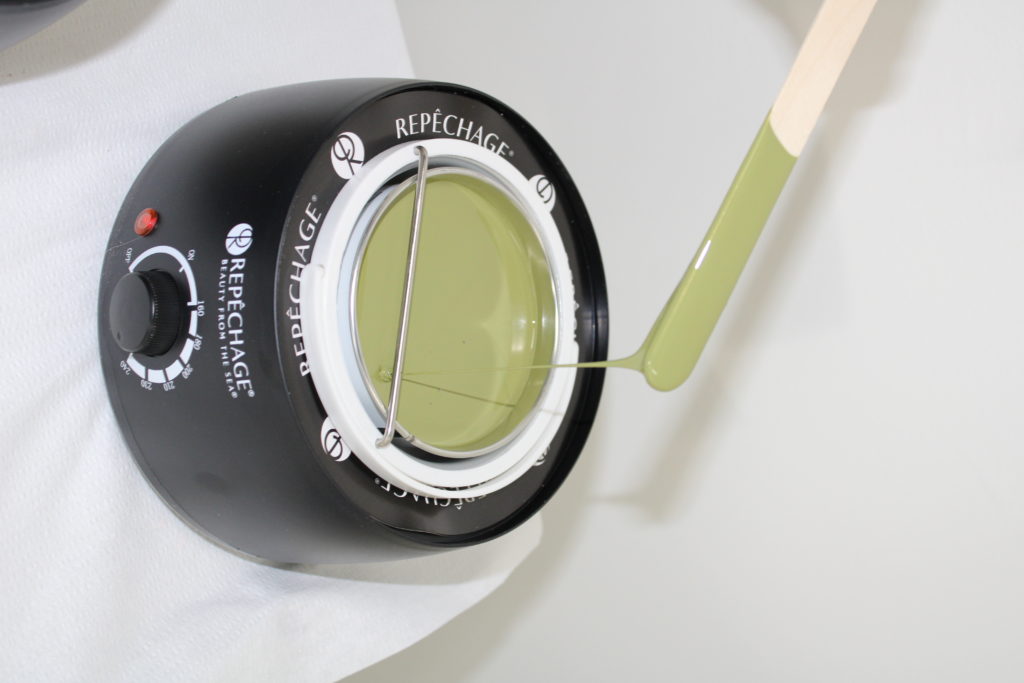
Waxing continues to be one of the most profitable services a spa or salon can offer. In fact, the global hair removal wax market is estimated to grow by 8.1% from 2020-2027, projected to reach $16.9 billion by 2027.
Yet, as people have returned to the spas and salons for their regular waxing services, their skin may be displaying new concerns. “After such a long time without services such as waxing, there have been many reports from clients experiencing new sensitivities,” says Louise O’ Loughlin, owner of Iguazu Beauty Ltd. in Dublin, Ireland. A recent study has found that the pandemic and conditions of lockdown and quarantine have had a detrimental effect on the skin. Complaints such as increase in skin sensitivity, skin dryness and even skin rash were significantly higher.
Incorporating skin care ingredients and treatments that help address this increase in sensitivity and dryness, such as an activated charcoal, found in the NEW Repêchage® Ubame Charcoal Wax and Chlorophyllin Copper Complex, found in the NEW Seaweed Mineral Hard Wax, can help create a more soothing experience for those returning to the salon.
Ubame Charcoal Wax provides a highly elastic hybrid texture between hard and soft wax that is not sticky and removes easily without irritating or causing redness. This wax is formulated for sensitive skin, combining ingredients that help to restore and purify skin, such as charcoal made with traditional Japanese charcoal from the Ubame oak, soothing and nurturing Seaweed extracts, minerals such as Zinc Oxide and calming Aloe Vera. This new form of wax is a lso suitable for all skin types and hair while it is strong enough to address course body hair.
Seaweed Mineral Hard Wax is perfect for thorough depilation of specific areas while helping reduce the appearance of skin sensitivity. Nutrient-rich Laminaria Digitata and Ascophyllum Nodosum Seaweeds help to soften skin while Chlorophyllin Copper Complex has astringent and antioxidant properties. Vitamin E, Aloe Vera and Safflower Oil help to soothe and calm the appearance of the skin.
Here, we will look at these new forms of waxes, including how activated charcoal is created and works in wax formulations, as well as provide protocol ideas for creating a more relaxing and restoring experience for the returning salon and spa goer.
If the client is just returning for regular wax services, it would be wise for estheticians to review the condition of their clients’ skin after a long absence from the salon, especially when performing waxing. Performing skin analysis and patch tests for clients that have been away from the salon for over six months should be a standard practice.
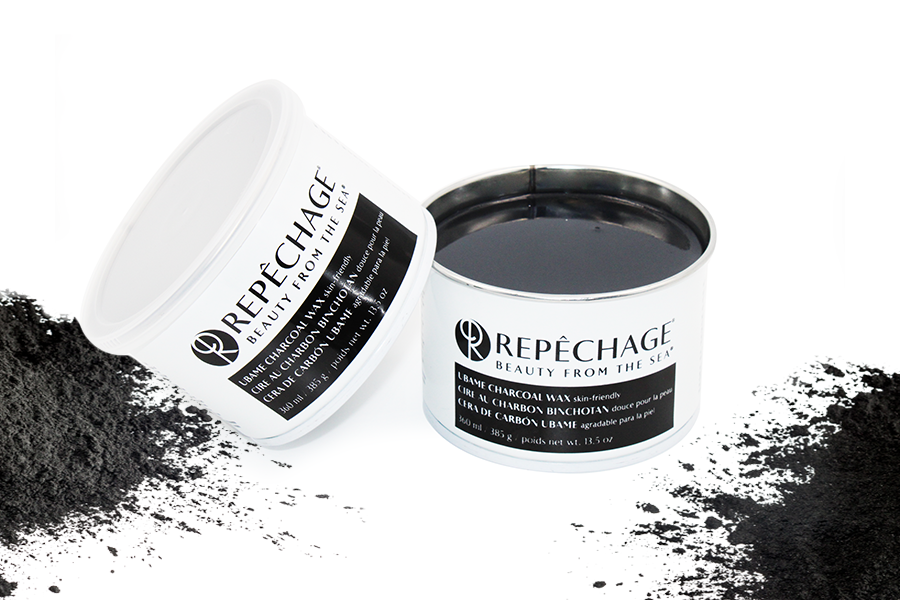
Activated Charcoal:
Making activated charcoal involves heating materials wood to very high temperatures, creating a porous charcoal that has more surface space and is able to absorb more. In fact, one teaspoon of activated charcoal is said to be equivalent in surface area to a football field. It is because it has this absorption ability that activated charcoal has been used for water purification, and is often used in poison control, helping to absorb and transport toxins from the body.
In skin care, activated charcoal has been shown to be beneficial for removing excess dirt and debris from the skin surface, and helping to unclog pores.
With waxing, the wax is applied to the skin surface, where it adheres to the hair shaft. Once in place, the wax is removed, taking the hair follicles with it. The charcoal in the wax helps to absorb additional dirt and impurities, providing for a more thorough deep cleansing of the area.
In wax formulations, the highest level of charcoal powder is Binchō-tan or white charcoal. Made traditionally in Japan from the Ubame oak, this charcoal is made by placing the wood in a kiln at approximately 240C° for 120 hours, then raising the temperature to approximately 1000°C. Once carbonized, the material is taken out and covered in damp mixture of dirt, sand and ash, which gives the charcoal its white quality.
The color itself is still black, but in comparison to other charcoal powders contains a more whitish hue. Throughout the trees lifespan a variety of minerals are absorbed which can be found in the Activated Charcoal Powder. The numerous small pores in White Charcoal also allow it to bind to toxins such as impurities and oil on the skin through adsorption and carry them out. This highly adsorptive quality of White Charcoal gives it a purifying and balancing effect on sensitive skin.
In combination with other skin care ingredients, charcoal wax can provide thorough depilation with long lasting results, create smoother looking skin and help reduce the appearance of redness and irritation.
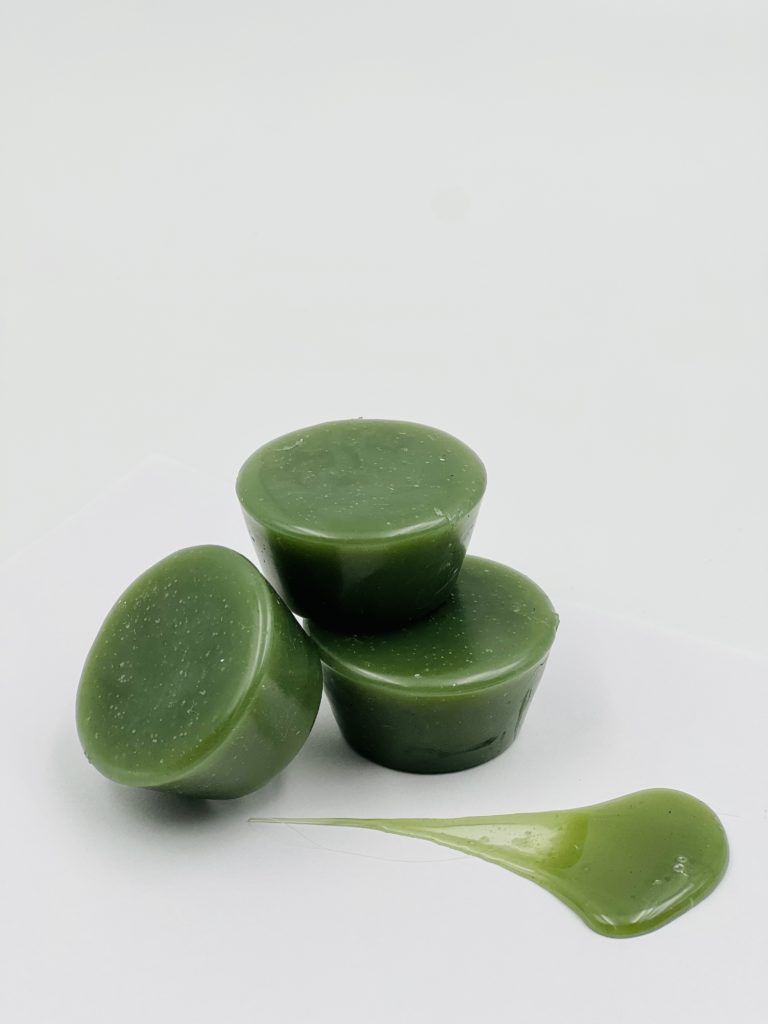 Additional skin care ingredients to look for in a wax formulation include:
Additional skin care ingredients to look for in a wax formulation include:
- Chlorophyllin Copper Complex: This complex is known to have astringent and antioxidant properties.
- Laminaria Digitata and Ascophyllum Nodosum Seaweed Extracts: These are rich in vitamins, minerals, amino acids and antioxidants, to help restore moisture and improve the appearance of the skin.
- Aloe Barbadensis Leaf Extract: Aloe is rich in minerals, amino acids, vitamins and enzymes and is known to help soothe the surface of the skin.
- Tocopheryl Acetate (Vitamin E): A powerful antioxidant known to help soothe the appearance of the skin.
- Safflower Seed Oil: This nutrient-rich oil is rich in antioxidant Vitamin E, and is known to help keep the skin soft and smooth.
- Zinc Oxide: A micronized mineral which can aide in absorbing excess oils and is also known to help minimize the appearance of skin irritation.
Creating a Relaxing Waxing Ritual:
Typically, many clients believe that waxing can be an uncomfortable experience, but it doesn’t have to be if you create a full body experience that helps to relax and soothe the client.
As clients return to the salons and spas for waxing and other skin care treatments, they need to be affirmed that the establishment exercises the highest level of safety, sanitation and hygiene.
Proper safety practices include proper hand washing using antibacterial hand soap for at least 10-15 seconds using gloves to ensure the safety of you and your client. These should be non-latex gloves that properly fit your hands. Consider using a protective portable and moveable polycarbonate shield over the clients face to further protect yourself and your client.
Also consider taking the complimentary CIDESCO course for certification in Sanitation and Sterilization. To receive the award, individuals need to request the complimentary workbook, which contains approximately 8-10 hours of study, designed for use in both the classroom and as a self-study resource. It provides all the information necessary to meet and exceed the curriculum requirements of all major international awarding bodies and incorporates all the resources to understand Sterilization and Sanitation and Occupational Health and Safety, covering:
- Personal Hygiene
- Public Hygiene
- Sterilization and Sanitation
- Precautions taken in the salon to prevent contamination and cross-infection
- Definition of terms in hygiene and sterilization, including the difference between Bacteriacide vs. Germacide, for example.
- Antiseptics and disinfectants
- Guides to standards in operating procedures for schools and salons during COVID-19
- Health and Sanitation laws and regulations
- Worksheets to complete at the end of each section for review and information retention
This study guide is available for free digital download through Esthetician’s Connection. You can also obtain a print copy through CIDESCO International at cidesco.com.
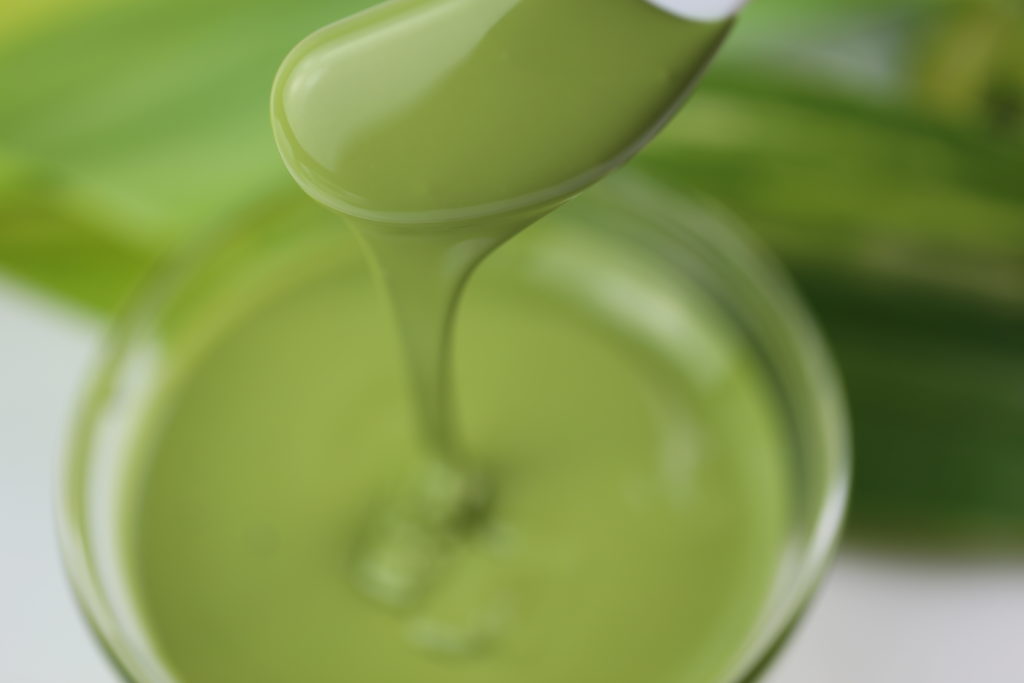
Be sure to provide the highest level of sterilization to remove all bacteria or other organisms that adhere to objects or instruments with the necessary treatment room equipment, including an autoclave, which utilizes both light and heat in a pressurized environment to kill microorganisms on metal, reusable implements such as tweezers. A Sanitizer utilizes both ultraviolet rays and ozone to sterilize and disinfect.
With a little creativity, it is possible to turn a waxing service into a relaxing spa experience that can actually be enjoyed, just like a massage or facial.
Before your client arrives, prepare the room so that it is inviting and comfortable.
Have a robe ready for the client’s arrival. Cover the table with a disposable sheet.
Place a beautiful bowl on the floor under where the clients head will rest. Fill the bowl with decorative accents such as flowers and calming aromatherapy oils. Once your client has changed into the robe, assist them onto the bed lying face down.
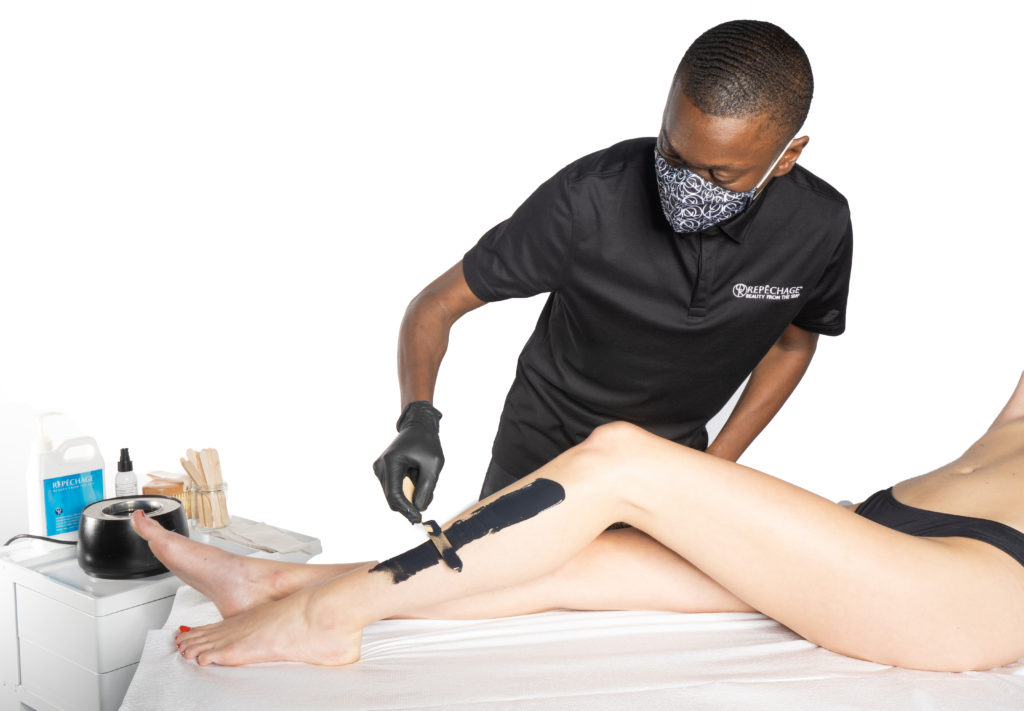 Spray alcohol on the area to be waxed. Use dry towel to remove any oil or cream from the skin. Sanitize skin and remove natural oils by spraying legs with alcohol. Follow with dry brushing with Vegan Body Exfoliating Brushes to gently lift hair to help reduce the appearance of ingrown hairs and to remove dead skin cells.
Spray alcohol on the area to be waxed. Use dry towel to remove any oil or cream from the skin. Sanitize skin and remove natural oils by spraying legs with alcohol. Follow with dry brushing with Vegan Body Exfoliating Brushes to gently lift hair to help reduce the appearance of ingrown hairs and to remove dead skin cells.
Using a clean spatula, apply Ubame Charcoal Wax to the skin in the direction of the hair growth using one long, smooth movement. Always use a clean spatula. NO DOUBLE DIPPING! Place Repêchage® Muslin Strips 100% cotton muslin strip over wax, leaving space to pull the strip. Apply gentle pressure to the strip and quickly pull back in the opposite direction of the hair growth. Do not pull up on the strip as this can cause breakage which will lead to ingrown hairs or even skin bruising.
Once you have finished waxing the back of the legs, you can massage with Skin Relief Cooling Gel which contains Seaweed extracts, Tea extracts, Aloe and Cucumber. One tip is to freeze this type of gel in a small plastic cup and apply to skin cold. You can also massage in a Seaweed Body Cream. For an added benefit, massage Vita Cura® CelluSea Lift™Body Contour Cream, a skin toning cream that contains Seaweed extracts, Caffeine and Coenzyme A into the thighs and buttocks area, then massage in using the hand held LED Radio Frequency and EMS Skin Tightening Machine set on Red to further the penetrations of the skin toning ingredients.
Assist client in turning onto their back to continue the waxing ritual. You can apply a Repêchage Seaweed-based Sheet Mask that addresses the client’s skin care concerns at this point to provide a full body experience. The mask can be chilled to have an even more relaxing, soothing experience. You can place soothing Eye Rescue Pads saturated with Seaweed, Tea and Cucumber extracts on the eyes, and gently massage face for a few moments using a Silver Ball Massager or a LED device.
Continue the waxing process on the rest of the areas of concern, then follow with Seaweed Body Cream or Vita Cura® CelluSea Lift Body Contour Cream on the upper thigh areas. Complete the experience by placing a cool, moist towel over the waxed area and remove the sheet mask.
Repêchage® Seaweed Mineral Wax can be used everywhere hard wax is needed, such as ears, nose, lip, chin, bikini and for manscaping. On cleansed skin, apply wax with a wooden spatula. Allow wax to cool and pull rapidly off the skin in the opposite direction of hair growth. Repeat until all hair has been removed from the desired area. Once you have finished waxing, apply frozen Repêchage® Skin Relief Soothing Gel on the areas waxed. Finish with Repêchage Seaweed Body Cream.
Now is the time to introduce your returning clients to new forms of wax and experiences to reinvigorate your business. These types of waxes can help transition your clients skin by being gentle on stressed, dry and sensitive skin, helping them return again and again to your spa or salon with confidence.

I really love this ,thank you for the info very informative as always. I learn so much from Repechage , love the products . Love Repechage.
Thank you Diane for being a loyal client. We hope you join our Lydia Sarfati Masterclass on waxing this summer.
Thank you!